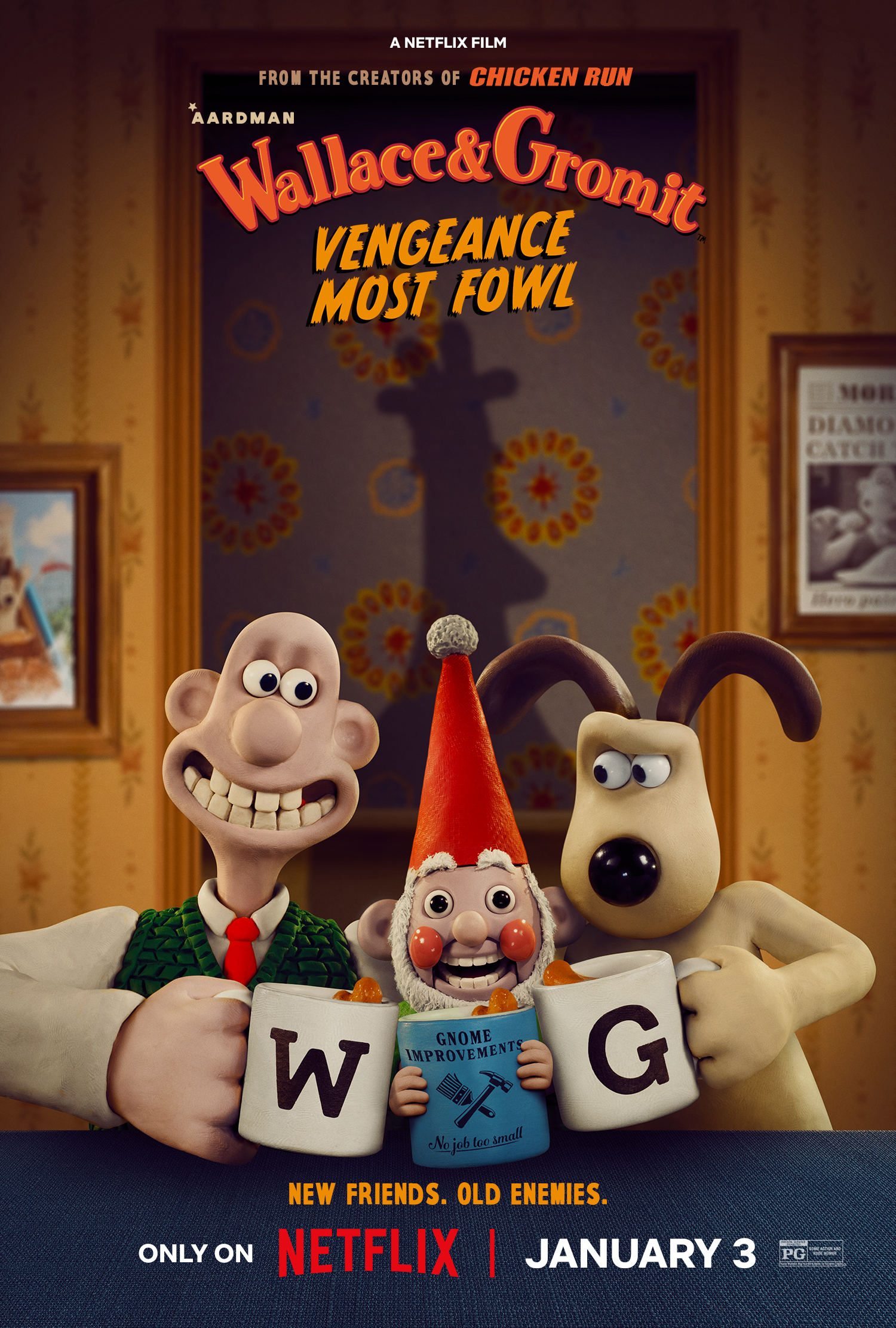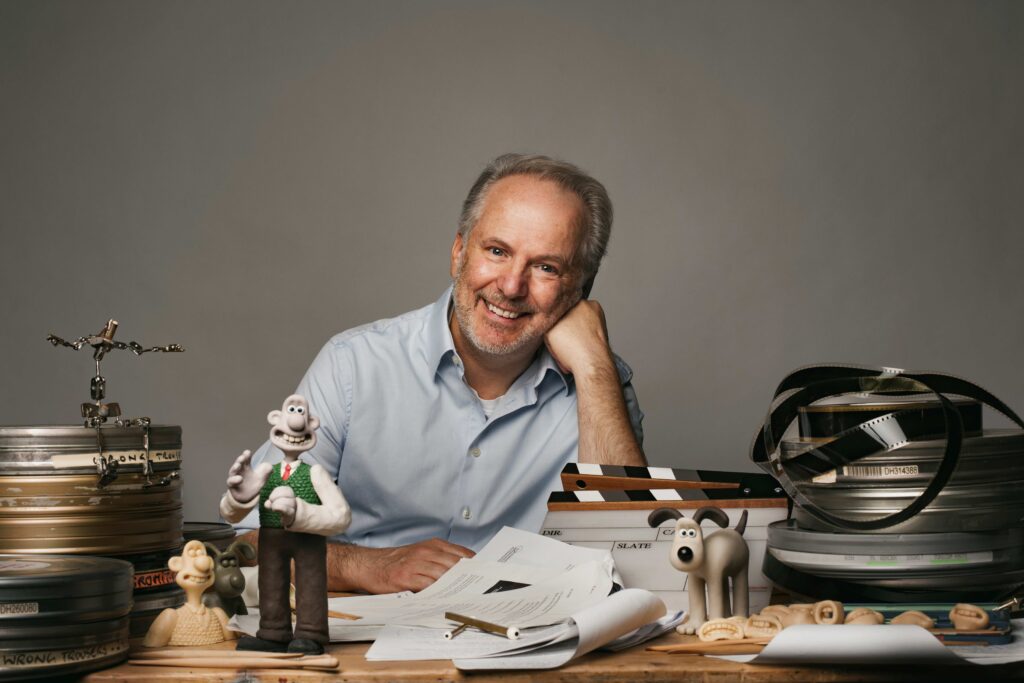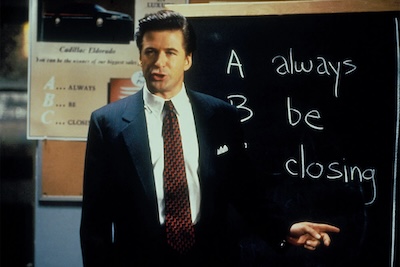 Nick Park, the creator of Wallace and Gromit, and his co-director Merlin Crossingham talk about their new film Wallace & Gromit: Vengeance Most Fowl. They give their thoughts on why these two characters have left such a lasting impact on so many viewers (including me). They also talk about finding the right balance in the classic claymation as well as new technology and how that mirrors the story of the film. Then of course, they reveal what it was like bringing back Feathers McGraw and why now was the perfect time. They also admit to how surprised even they were at fan excitement for the characters’ return.
Nick Park, the creator of Wallace and Gromit, and his co-director Merlin Crossingham talk about their new film Wallace & Gromit: Vengeance Most Fowl. They give their thoughts on why these two characters have left such a lasting impact on so many viewers (including me). They also talk about finding the right balance in the classic claymation as well as new technology and how that mirrors the story of the film. Then of course, they reveal what it was like bringing back Feathers McGraw and why now was the perfect time. They also admit to how surprised even they were at fan excitement for the characters’ return.
The Contending: Where did the idea for this Wallace and Gromit story come from?
Nick Park: The idea of Wallace creating the smart gnome to help Gromit in the garden came about back when we were making Were-Rabbit. I was tinkering around with that idea for many years on and off while working on other things. Every time I pitched the idea it had great potential, but it was about tech going wrong, which seemed a bit usual. It was only later when the idea of bringing Feathers McGraw back seemed to be the great answer to that problem. His history with Wallace and Gromit made it a lot more personal and it certainly added something more sinister. Screenwriter Mark Burton was fired up by this, and then Merlin and I kept developing that idea.
The Contending: Merlin, you have worked with Aardman for a while now, but this is your first feature film and it is with these two iconic characters. What was that like?
Merlin Crossingham: Well, it was very exciting and nerve-wracking all at the same time. I’ve worked with Nick over the years as an animator, then as a director, and then creative director for Wallace and Gromit. So the world of Wallace and Gromit is familiar territory for me. I’ve directed many things but not a feature film. I’ve worked on feature films as an animator and animation director, but stepping up to share directing responsibility with Nick was, apart from anything, an opportunity not to be missed. When Nick asked me I did not need a second to think about it. It was something I jumped at the chance of and I’m glad I did. It has been a wonderful experience.
Nick Park: Merlin was a very natural choice for me as well. For all those reasons.
The Contending: You mentioned bringing back Feathers as a way to help bring this story together and I know fans that have been wondering and waiting for this character to come back. What was it like bringing him back and making it feel right this moment?

Nick Park: Well, it was very much that he was the perfect solution to a story problem really. We didn’t really bring him back in a premeditated sort of way, and as soon as we brought him into the story it upped the ante of the story and suddenly it became a feature film. Before, the gnome idea was originally a thirty minute TV short. So it organically grew into what it is. Then we realized when we announced it that oh, my, this is what all the fans were waiting for! We hadn’t quite registered that. People had asked when he was coming back, but there had never been any real good reason or concept to do it. Then we realized that everyone was expecting it.
Merlin Crossingham: And pleasantly surprised by the overwhelming reception as well!
The Contending: Think you’ll be using him again, or should he be used more sparingly?
Nick Park: Hmm, probably sparingly.
Merlin Crossingham: He is the first time any character has reprised his role in Wallace and Gromit besides Wallace and Gromit. The secondary characters have always been contained within the different films.
Nick Park: But who knows? He’s somewhere in Yorkshire. Don’t know what he’s doing.
Merlin Crossingham: Badlands.
The Contending: There is one shot that has stayed with me. It’s with the blue diamond where it’s been revealed and it’s being held up very reverently and we get Wallace and Gromit in this reflection of it. What was behind some of the choices for that shot?
Nick Park: It was using the diamond as a flashback device is what was attractive, as well as this is Feathers moment where he’s finally got the prize. The beauty of stop motion is that you have real sets and characters that you can play around with the camera and the lighting in different angles. We did have to use digital assistance a lot on this to get the vision we wanted, where here we zoom into the diamond and go back in time and back to the present day. It was a lovely device to do that.
Merlin Crossingham: A lot of it was making the prize that Feathers has been after as epic and fantastical as it could possibly be. With all the light shining around and the way he’s holding it, all of that music as well plays a huge part in setting the atmosphere. I think it was all about making it as powerful and funny as it could be.
Nick Park: We talked to Julian Nott and Lorne Balfe, the composers, and told them this is the Nazis getting the Ark of the Covenant.
The Contending: You mentioned the humor of the scene and Wallace and Gromit have had this whimsy and its puns, where kids can enjoy it and adults enjoy it and the kids that have grown up with it and are adults still enjoy it. What do you think it is that keeps people so engaged with these characters?

Nick Park: I have to pinch myself because I thought of these characters in college and finished A Grand Day Out three years in film school. Then Peter Lord and David Sproxton at Aardman offered to help me finish the film, so it took seven years altogether. It was a slow go to start with, and wasn’t an overnight success. It was after making The Wrong Trousers that it really began to pick up with the stories getting better and less whimsical and more stylized. I think it has something to do with the clay. I think it has something intrinsically to do with it, the sense that I know what that is, I have played with clay. Plus it’s about a relationship with a man and his dog, which is great for comedy
Merlin Crossingham: I think there’s an honesty about Gromit as well, that people connect with young and old. It’s his story, his adventure really. In talking to people at the premiere of Vengeance Most Fowl, as you said, we’ve been meeting people who watched it as a youngster and now have revisited Wallace and Gromit again and are going, “I saw a whole load of different stuff that I didn’t see when I was young!” That is great to hear because that’s exactly what we really want. Something for everybody.
Nick Park: Wallace and Gromit films have never talked down to kids. The movies introduced them to a whole new world of adventure with comedy, emotion, and drama. It’s not too young in its feel or its tone and even a little bit scary. But it’s full of invention and trying to be unique and not too kitsch or cliche, just playing on cliche if anything. That is important.
The Contending: Speaking of having all that, the chase in the canal you have the humor of how they’re chasing Feathers, and this invention with shoes. But then you also have this epic over the top explosion, which had me bursting out laughing, then you have this balancing act with a real sense of danger. What all went into that sequence?
Merlin Crossingham: Everything went into making it. (laughing) Right at the beginning of the film I remember Richard Beek, our producer, saying to us, “Where do you want to put the money? Because act three is big.” We said, “Yeah, we want to put it in act three, please.” We wanted it to be as big and as bold as we could within the time and the framework.
Nick Park: We knew that coming out of that cliff face that it better be spectacular here and not be limited by the stop-motion. Just going for it and trying to be epic. There is this constant throughout the movie, even when it’s slow it has to keep escalating and the escalation is really big here. With what Robert Mickey calls reversals, where you think something’s happening and then something else happens. You think he has the diamond but no, he has a turnip.
Merlin Crossingham: We talked a lot with Mark Burton, the screenwriter, about who is in control. Where sometimes Feathers is in control and Gromit is on the back foot. Then something happens and Gromit is on the ascendance and Feathers is down. The switching of power in that sequence was also very important as a structure that we could build the story and the humor around.
The Contending: Another story beat in the film is Wallace’s over-dependence on his gadgets, and yet it also very clearly shows that the gadgets do not need to be a bad thing. That maybe Wallace should be patting his dog and, even though the gnomes acted up, they are actually very useful and good things. How did you go about trying to handle that balance, especially with the character who is so well known for inventing things?
Nick Park: As you were saying, Wallace is a mad inventor but he does it for good reasons. So I guess it’s about keeping a balance. We’re not trying to preach any black and white approach. It’s more a question in the story of how tech is enhancing our lives in all sorts of ways, but are there some ways that may be taking away from our human experience in ways we are not aware of?
Merlin Crossingham: Certainly Wallace learns about being overly dependent. But it’s also a big thing for Gromit to realize this slightly crazy inventing is a very vital part of who Wallace is. This is certainly not an anti-technology story. It is, where’s the balance? Because not having any gadgets is no good for Wallace.
Nick Park: Like Gromit, we ourselves embrace the technology when the clay cannot do everything for us. Even though the animation clay is at the heart of everything that we do on this film and gives it its authenticity. But, like Gromit, we may not give it an epic embrace, but we embrace it ourselves.
Merlin Crossingham: The way we made the film definitely mirrors the story: the handcrafted-ness as well as using the latest cutting edge post-production technology. There is a lovely harmony between the two.
Nick Park: It’s like Gromit gardening. He loves gardening, so why would you take it away with technology that makes it so he doesn’t have to? There are so many things in life that lend itself to that kind of comedy with tech. Why would we invent something that takes away our human experience?
The Contending: Final thoughts?
Merlin Crossingham: Watch our film and hopefully you’ll enjoy it!
Nick Park: If there is a moral to the story it’s don’t trust the penguin with the rubber glove on his head.
Wallace & Gromit: Vengeance Most Fowl will be on Netflix January 3, 2025.






![Kameron Lennox On How Ambition and Drive Fuel the Costumes of the Wild Personalities of ‘The Studio’ [VIDEO]](https://thecontending.com/wp-content/uploads/2025/06/studio-120x86.jpg)


